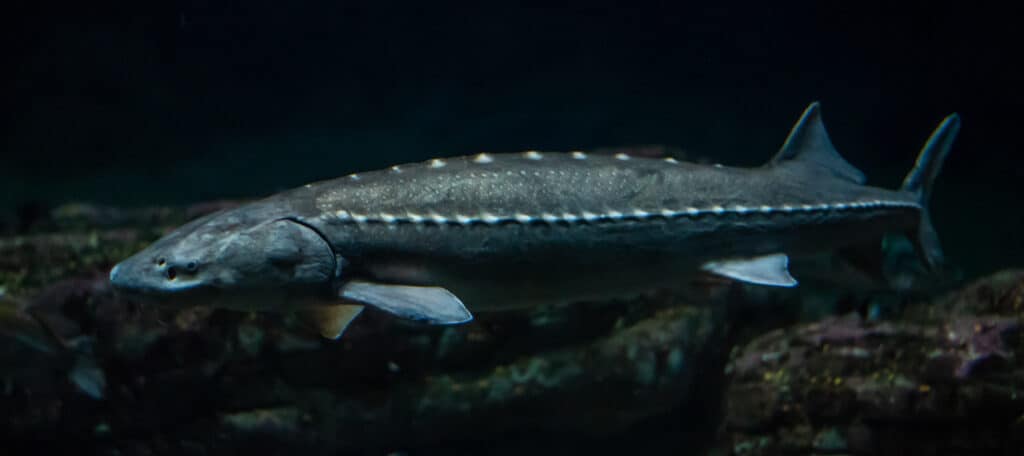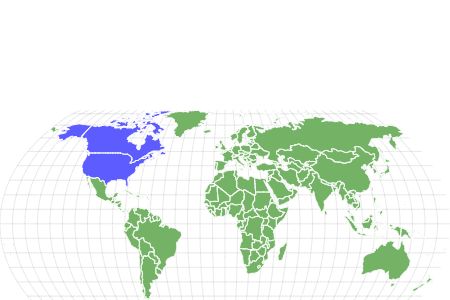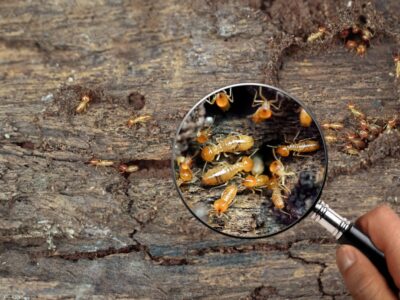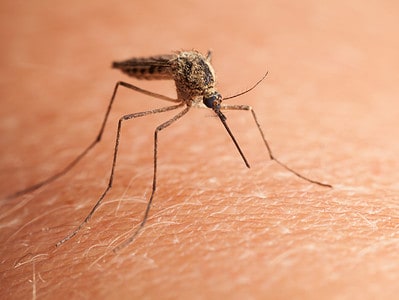Atlantic Sturgeon
Acipenser oxyrinchus oxyrinchus
Atlantic Sturgeon often leap out of the water.
Advertisement
Atlantic Sturgeon Scientific Classification
- Kingdom
- Animalia
- Phylum
- Chordata
- Class
- Actinopterygii
- Order
- Acipenseriformes
- Family
- Acipenseridae
- Genus
- Acipenser
- Scientific Name
- Acipenser oxyrinchus oxyrinchus
Read our Complete Guide to Classification of Animals.
Atlantic Sturgeon Conservation Status
Atlantic Sturgeon Facts
- Prey
- Crustaceans, mollusks, sea worms, smaller fish
- Group Behavior
- School
- Fun Fact
- Atlantic Sturgeon often leap out of the water.
- Biggest Threat
- Overfishing and habitat changes
- Most Distinctive Feature
- They have bony scutes rather than scales.
- Average Spawn Size
- 400,000 - 4 million
- Habitat
- Atlantic Ocean and rivers when spawning
- Diet
- Omnivore
- Lifestyle
- School
- Favorite Food
- mollusks, crustaceans, small fish
- Number Of Species
- 1
Atlantic Sturgeon Physical Characteristics
- Color
- Blue
- Black
- White
- Olive
- Skin Type
- Boney Plates
- Lifespan
- 5-60 years
- Weight
- 300-800 pounds
- Length
- 5-14 feet
- Age of Sexual Maturity
- 24-48 months
- Venomous
- No
- Aggression
- Low
View all of the Atlantic Sturgeon images!
If you want to see an 800-pound fish, just look for an Atlantic Sturgeon.
These giant fish are living fossils and look just like fossilized specimens that have been discovered. Once caught for their roe to use as caviar, the Atlantic Sturgeon is now protected under the Endangered Species Act. They have 5 known populations in the Western Atlantic, off the coast of Canada and the United States.
Atlantic Sturgeon Facts
- The largest known Atlantic Sturgeon was 14 feet long and more than 800 pounds.
- They can get up to 60 years old in some areas.
- Atlantic Sturgeon are a subspecies of Acipenser oxyrinchus. Their relative is the Gulf Sturgeon.
- While they live the majority of their adult lives in the ocean, they return to the same river where they were born to spawn.
- Atlantic Sturgeon have 4 whiskers, called barbels, near their mouths.
Classification and Scientific Name
The Atlantic Sturgeon is actually a subspecies of Sturgeon known by the scientific name Acipenser oxyrinchus oxyrinchus. Along with the Gulf Sturgeon, Acipenser oxyrinchus desotoi, these Sturgeon are very similar other than where they live. They are each named after their habitat.
They are part of the Acipenseridae family. This includes 27 total species of Sturgeons, all of which display the characteristic scutes of these fish rather than scales. The Atlantic Sturgeons belong to the Acipenseriformes order. In addition to Sturgeon, paddlefish belong to this order. They are part of the Actinopterygii class, also known as ray-finned fish. These fish have rays that support their fins rather than lobes. Over half of all known vertebrates are ray-finned fish. Atlantic Sturgeon are part of the Chordata phylum and Animalia kingdom.
Atlantic Sturgeon Appearance
Sturgeons are unique among fish because they don’t have scales. Instead, they have scutes. Scutes are bony armor, found on crocodiles, turtle shells, and birds’ feet. Sturgeons are considered a living fossil because of their resemblance to now-extinct species. They have an arched back, which makes them easier to recognize by their silhouette, even at a distance.
They live for many years and can grow to be very large. The largest Atlantic Sturgeon ever recorded was 14 feet long and weighed over 800 pounds. Most are closer to 6-8 feet long and around 300 pounds. This is still a large fish, even when it is a smaller specimen.
Most are dark blue, almost black, although some can have a greenish tint as well. Their bellies are lighter and white in places. They are bony-looking due to their scutes. Atlantic Sturgeon also have a long snout with four barbels on the front. These look and act similar to whiskers, giving information about their environment.
You may see an Atlantic Sturgeon leaping out of the water. Because they are so large and have bony scutes, this can even be dangerous if they do so unexpectedly. There have been historical accounts of Sturgeon leaping near boats and actually knocking people over. While scientists do not know exactly whey they do this, they think that it is a form of communication.

The bony scutes, or body armor, give the Atlantic Sturgeon a prehistoric appearancew.
©David A Litman/Shutterstock.com
Distribution, Population, and Habitat
As their name suggests, Atlantic Sturgeon live in the Atlantic Ocean. They are mostly found in the Western Atlantic off the coast of Canada and the United States. These fish live as far north as the waters off New Brunswich and extend as far south as the Atlantic Ocean off the Florida coast. They are also present in rivers all the way to the Mississippi, although changes in their habitat impacted their population.
Atlantic Sturgeon live in brackish water when they are young and move to deeper water as they mature. They come back to freshwater when it is time to spawn.
Atlantic Sturgeon are considered endangered. Under the Endangered Species Act, they are divided into five Distinct Population Segments, DPS, of the overall population. These include:
- Carolina DPS
- Chesapeake Bay DPS
- New York Bight DPS
- South Atlantic DPS
- Gulf of Maine DPS
Conservation efforts in each location differ based on the needs of the environment. Certain rivers have been designated as Sturgeon habitats as well, including the James River in Virginia. Atlantic Sturgeon tend to return to the same rivers to spawn throughout their lifetimes. This helps scientists study their behavior as well as recommend concrete steps to protect these areas and the Sturgeon population. Factors that influence their population include overfishing, habitat destruction, and changes to rivers through manmade influences such as dams and bridges.
There was once a small population in the Baltic Sea, although Atlantic Sturgeon have not been seen in the area since one was caught in 1996. There have been some recent efforts to reintroduce the species to the area and encourage spawning to rebuild the population.
Predators and Prey
Atlantic Sturgeon spend much of their lives at the bottom of the ocean and rivers where they live. They find their food on the sea floor. They like to eat crustaceans and mollusks, as well as sea worms and other smaller fish that also live on the ocean floor.
Their bony scutes act as effective armor and there are few other animals that can eat the Atlantic Sturgeon. The biggest threat to these fish historically has been fishing. They were caught for their meat as well as their leathery skin. Atlantic Sturgeon eggs were prized for caviar, leading to a significant decline in their population as fishermen started fishing specifically for Sturgeon.
Now, the main threat to the Atlantic Sturgeon is the decline in its habitat. It is sometimes still caught as bycatch when using nets and trawls, although conservation efforts have led to greater awareness of its endangered status. Commercial fishing operations take measures to prevent the bycatch of Atlantic Sturgeon based on the time of year, equipment, and location. They also work to release any bycatch safely.
Atlantic Sturgeon go upstream in rivers to spawn. Adding structures such as dams and locks can make this impossible, leading to a significant decline in future Sturgeon populations. Specifically, the Cape Fear River in North Carolina, the Santee-Cooper Rivers in South Carolina, and the Savannah River in South Carolina and Georgia have structures that make getting upstream difficult for Sturgeon. Dams in the Penobscot River in Maine and the Rappahannock River in Virginia have been altered or removed to allow for greater access to help the Sturgeon population.
Reproduction and Lifespan
Atlantic Sturgeon swim upstream in rivers to spawn. Each female lays up to 4 million eggs, although she only spawns once every 2-4 years. Younger females tend to lay fewer eggs, usually around 400,000. The females do not stay with the eggs and instead swim back down the river. The males sometimes stay upriver for some time but eventually swim back downriver as well.
When they hatch, young Sturgeons stay in brackish water for the first few years of their lives. When they are around 6 years old and between 3 and 5 feet long, they move out to deeper water.
Atlantic Sturgeon lifespans vary based on where they live. The further north they live, the longer the Sturgeon lifespan can be. Atlantic Sturgeon that live in the South Lawrence River in Canada can live up to 30 years or more, while those that live in rivers in South Carolina typically live to between 5 and 19 years. Southern Atlantic Sturgeon grow and mature faster than their northern counterparts that live in colder water. Some of the oldest Atlantic Sturgeon are thought to be around 60 years old.
Atlantic Sturgeon in Fishing and Cooking
Because of their protected status, it is illegal to catch Atlantic Sturgeon or harvest their eggs. In the past, Atlantic Sturgeon caviar was considered a delicacy and imported around the world. Atlantic Sturgeon meat was also eaten, although less frequently.
Because these fish are quite large, one Sturgeon could provide plenty of meat. Their significant value came from collecting their roe, however. Not only did this take one Sturgeon out of the population, it also impacted many potential new Sturgeon by interfering with the spawning behavior.
Similar Fish to Atlantic Sturgeon
Gulf Sturgeon: This is the other subspecies related to the Atlantic Sturgeon. It lives in the Gulf of Mexico and nearby rivers. The Gulf Sturgeon is also listed as endangered.
Salmon: This sustainably caught fish is a good substitute if you want to eat a tasty fish dish that will not have a negative impact. It can be prepared in a similar way to traditional Sturgeon dishes. Salmon roe also makes delicious caviar.
View all 194 animals that start with AAtlantic Sturgeon FAQs (Frequently Asked Questions)
Why do Atlantic Sturgeon jump out of the water?
Scientists do not know exactly why Sturgeon leap out of the water. They hypothesize that it is a form of communication between them.
Can you keep Atlantic Sturgeon?
No, it is illegal to keep Atlantic Sturgeon. The space and habitat requirements also make it impractical, since Sturgeon need freshwater rivers to spawn and saltwater to live the rest of their adult lives.
Why are Atlantic Sturgeon important to the ecosystem?
Atlantic Sturgeon are very sensitive to changes in the salinity of their environment. They are a helpful indicator that rivers, streams, and oceans are balanced. If the Sturgeon have trouble surviving and spawning in a river, it is a good indicator that there is a problem with the overall environment.
Thank you for reading! Have some feedback for us? Contact the AZ Animals editorial team.
Sources
- Chesapeake Bay Program, Available here: https://www.chesapeakebay.net/discover/field-guide/entry/atlantic_sturgeon#:~:text=The%20largest%20Atlantic%20sturgeon%20ever%20recorded%20was%20caught%20in%20Canada,long%20and%20weighed%20811%20pounds.
- Maryland Dept. of Natural Resources, Available here: https://dnr.maryland.gov/Fisheries/Pages/Fish-Facts.aspx?fishname=Atlantic%20Sturgeon
- U.S. Fish and Wildlife Service, Available here: https://www.fws.gov/species/atlantic-sturgeon-acipenser-oxyrinchus-oxyrinchus
- NOAA, Available here: https://www.fisheries.noaa.gov/species/atlantic-sturgeon


















